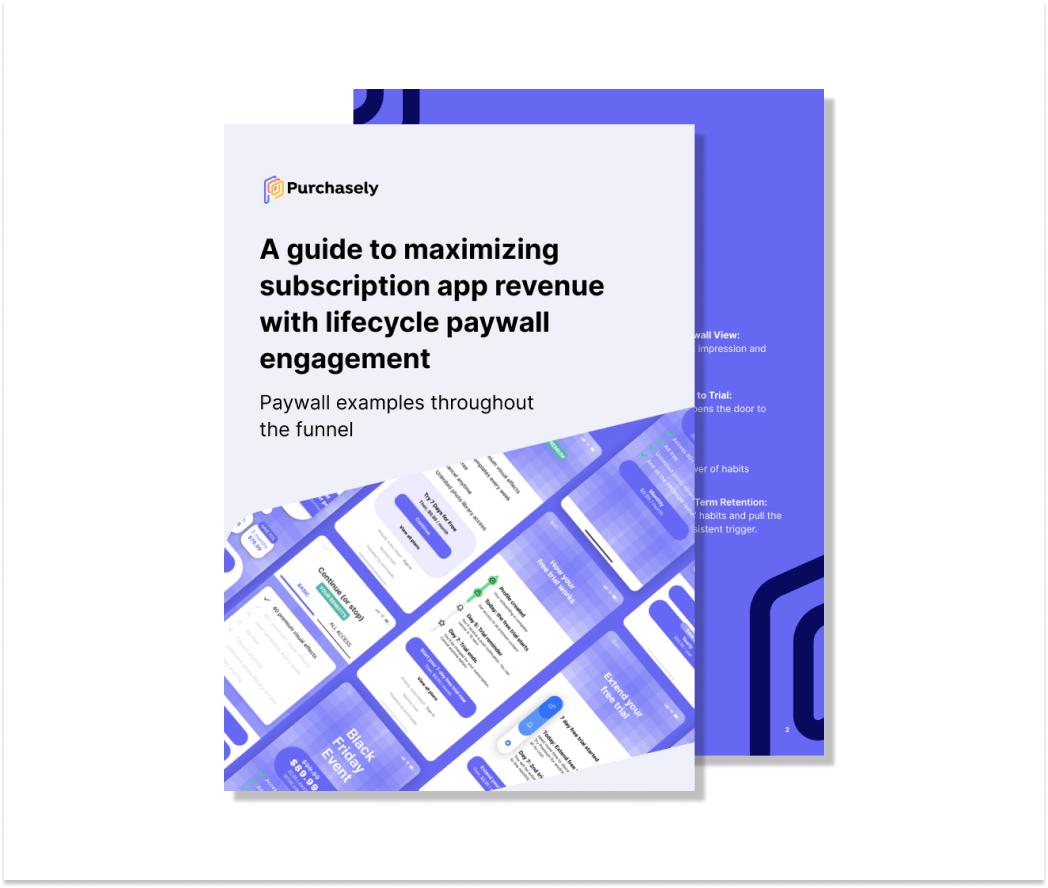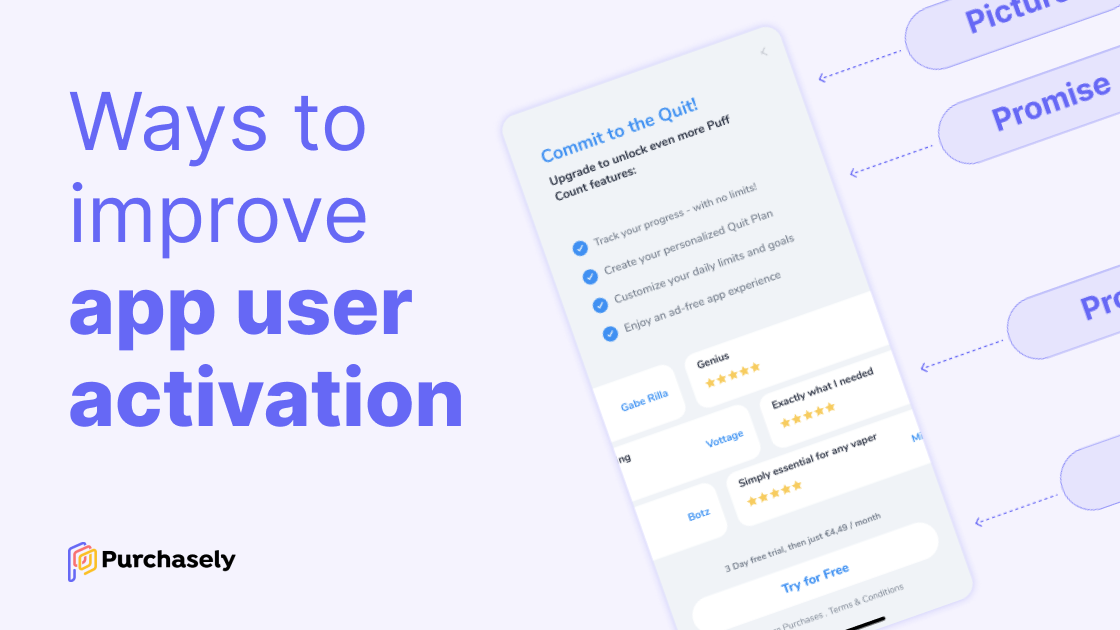
Ways to improve app user activation
Bomee Lafitte
Content Marketing Manager @ Purchasely
Introduction
Every app marketer knows getting users through the door is hard. But turning that "Oh, this looks interesting" to a committed "this is it" is where the real challenge lies.
Activation is a crucial pivot point where a user's interest transforms into a tangible action, a metric that can make or break an app's success.
This article deep dives into the nuances of user activation, shedding light on how to optimize experiences within your app, ensuring users not only stay but become actively involved.
Outline
- Have an onboarding- Introduce the first paywall post-onboarding
- Hook with incentives
- Optimize copy (copywriting frameworks and usage examples)
What is app user activation?
Think of the activation rate as a scorecard. It tells us how many users reach a key moment in the app early on in their in-app journey.
The key moment varies from app to app.
-
For a dating app, it might be when users hit their first 10 likes.
-
For a fasting app, it might be when users successfully finish going through the onboarding screens.
-
For a news app, it might be when users read all free articles.
-
For a fitness app, it might be when users subscribe to a premium plan.
These moments, often turn users into regulars or paying customers.
App user activation is the most crucial pirate metric
You've probably heard of "pirate metrics", AKA AARRR. This insightful breakdown - Acquisition, Activation, Retention, Referral, and Revenue - is a creation of Dave McClure from 500 Startups, a framework designed to help startups navigate their growth.
.png?width=736&height=499&name=Purchasely%20Blog%20-%20Pirate%20metrics%20(startup%20product%20management%20framework).png)
Most startups and early-stage apps are quick to dive into the acquisition pool aiming to scoop up users. Retaining them is, of course, the next big challenge.
But there's a pivotal step in between that often gets sidestepped: Activation.
Let’s break it down:
-
First impressions count: Your app's activation phase is one of the first in-app experiences users have. Nail this, and you've set a positive tone for their entire journey with your product. If they struggle to find value or face usability issues, chances are they won't stick around.
-
The bridge to success: Think of activation as the bridge connecting user acquisition to retention, referral, and revenue. There are different views on the sequence between the three Rs but what’s clear is that without the activation, users will not make it to the other side.
-
Savings in user acquisition: Efficiently activating users can mean you spend less to bring each one on board. This cost-saving, paired with a solid Monthly Recurring Revenue (MRR), strengthens your app's financial standing.
-
Happy users, more referrals: When users are engaged and find value, they're more likely to shout about it, leading to organic referrals. These new users, acquired at a lower cost, can further amplify your MRR.
-
A feedback goldmine: Keeping an eye on activation metrics is like having a compass for product improvement. Addressing areas that users stumble on can boost activation rates, positively influencing MRR.
Your long-term MRR trajectory can look drastically different with a focused activation strategy. Take a peek at the graph below to see the difference.
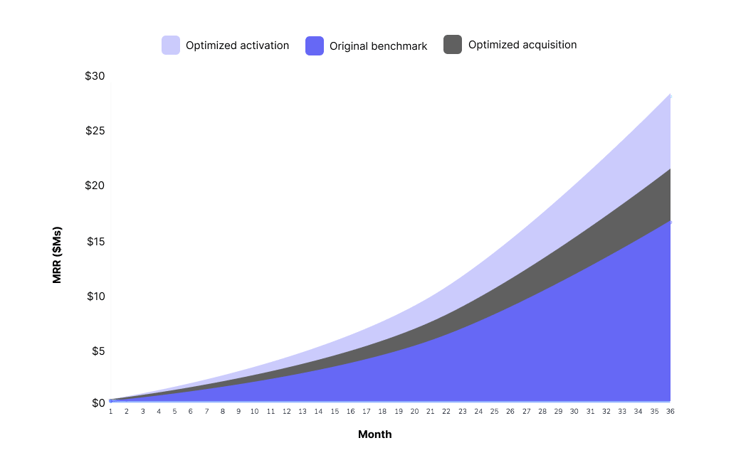 A 25% increase in acquisition can lead to a 25% MRR boost, while a 25% increase in activation can lead to a 34.3% MRR increase.
A 25% increase in acquisition can lead to a 25% MRR boost, while a 25% increase in activation can lead to a 34.3% MRR increase.
Optimizing activation can impact MRR more than optimizing the pre-activation stage.
Appcues' research reveals that activation directly influences revenue, encompassing new user income and recurring revenue from existing users.
For example, if a 25% increase in acquisition results in a 25% MRR boost, the same level of improvement in activation can lead to a 34.3% MRR increase.
Increased activation will also likely boost retention and referrals, making it the pivotal upstream bottleneck that can grow or shrink the entire funnel.
User activation rate benchmark
According to Airship’s research on activation, activation rates in various app sectors typically peak early on and then taper off as time progresses.
.png?width=500&height=314&name=pasted%20image%200%20(1).png)
Image source: Airship
Airship found that the top-performing apps also excel at activating users, with their day 30 activation rate standing 56% above the average for their category.
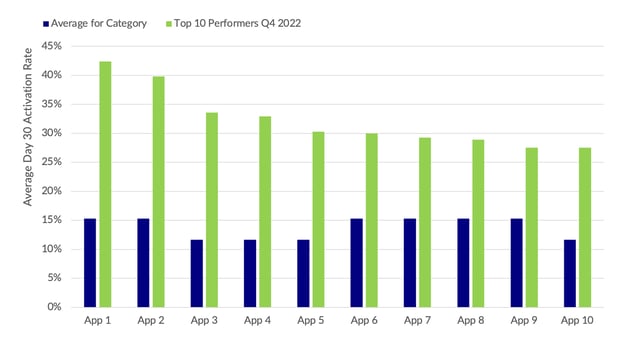
Image source: Airship
How to increase activation
Now that we've tackled the basics, let's get into the hows.
1. Have an onboarding
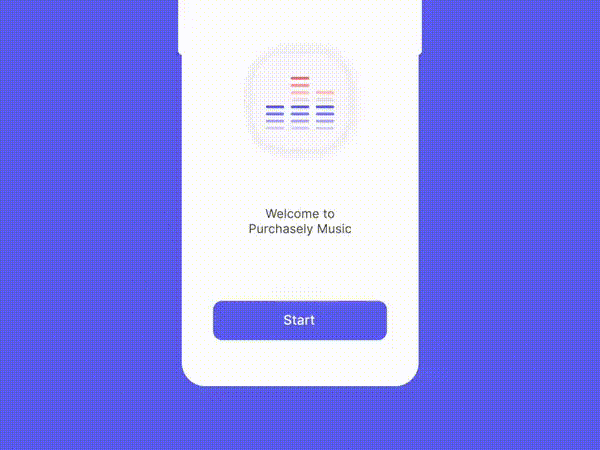
Stepping into an app for the first time is like walking into a party where you don’t know a soul. You either strike up some fun conversations or find yourself in awkward moments you wish you could 'undo'.
Offering an onboarding flow is like having a friendly guide show you around, pointing out the cool spots, and making sure you share the vibe.
Steve P. Young, founder of App Masters highlighted the importance of onboarding at the Mobile Growth Association workshop with a jaw-dropper: 60% of users decide to make a purchase right during their onboarding journey.
Making this crucial phase impactful is though, another challenge.
Below are some tips.
How to offer an effective onboarding experience
-
Show value earlier: Familiarize your users with what your app offers. Present content catalog, show core value and feature as quickly as possible
-
Don’t overplay: Then you may ask: Is “more” the “better”? Yes and no. While trying to get users on board with rich information up front is well-intentioned, going overboard can be overwhelming. Expand the real estate of your pitch instead of squeezing everything into a single screen. Whether through deep links, long paywall formats, video content, or any other means, ensure you pack in rich details in a captivating manner. Make sure to allow users to skip or dismiss if they choose easily.
-
Social proof: Borrow other’s voices to show that your app is a real deal. Enhance the feeling of assurance and belonging by showcasing testimonials, user-generated content, real user progress, or influencer stories.
-
Personalize it: Tailor the onboarding flow to individuals. Based on earlier input and selections, show content tailored to user data and interest. This approach helps you to expose more relevant features to each user.
-
Show progress: Use progress bars or checklists to represent the progress. These can motivate users to complete the onboarding process and become a gamification element.
-
Less words, more images: A picture truly is worth a thousand words. Incorporate static or animated images to capture maximum attention while conveying rich information.
2. Introduce the first paywall post-onboarding
Deploying a paywall right after the onboarding sounds like a bold move. However, this strategy is grounded in a fundamental understanding of user behavior.
-
Immediate value proposition: Users have just been introduced to your app and its features during the onboarding. Capitalize on this momentum by showcasing your premium offerings immediately. It's an opportunity to reinforce the app's value by presenting side-by-side basic versus advanced features.
-
Emotional engagement: Fresh from the onboarding experience, users are likely still curious and excited. Presenting a paywall at this juncture plays on this heightened emotional state, increasing the chances of securing a conversion.
-
Keep it flowing: It's essential that this early paywall doesn't come off as too aggressive. Make sure it feels like an integral part of the onboarding and that it offers genuine value.
-
Allow skipping: The same rule to allow “options” applies here too. While presenting an early paywall can be effective, ensure that users can easily skip or defer this step. The key is to communicate value without alienating those who aren't ready to commit just yet.
3. Hook with incentives
Dangling a little carrot can sometimes go a long way. Users, especially the new ones, love feeling like they've scored a deal or unlocked a special reward. When it comes to ushering users swiftly to activation, promotions, discounts, and non-committed free trials can be your secret weapons.
Here’s how offering incentives early on in the app journey taps into users’ minds.
-
Instant gratification: People love immediate rewards. Offer them special deals, limited-time promotions, or even a glimpse of premium features for a short trial period. This gives them a taste of what’s beyond the basic version, enticing them to dive deeper.
-
FOMO (Fear of Missing Out): Limited-time discounts or exclusive offers can trigger this psychological response. When users believe they might miss out on a good deal, they're more likely to commit.
-
Test the waters: Non-committed free trials give users a chance to explore the premium side without feeling the weight of a commitment. If they like what they see, they might just stick around longer than you'd expect.
4. Optimize copy
Your life could be so much easier if your app spoke for itself and you never had to use words to persuade users to get past the activation stage.
Unfortunately, it doesn't work that way. The time to impress is short; you want to shorten the learning curve before user attention drains completely.
That's why you'll want to bring your A-game in copywriting everywhere in your app where words capture users' attention.
Typically, onboarding screens and the first paywall screens are where you'd want the magic to happen.
But, as we often remind our readers, there's never really magic behind the magic. This means crafting in-app marketing copy that efficiently activates users requires careful consideration and strategic planning. Only with these in place can you:
-
Nail the perfect message every time.
-
Streamline your voice with a go-to blueprint.
-
Hook and charm your users.
-
Write copies much faster.
-
Skyrocket those activation metrics.
Here are 3 popular copywriting frameworks with application examples you can experiment with.
1) 4 Ps (Promise, Picture, Proof, and Push)
-
Picture: First, help users visualize either their problem or aspiration.
-
Promise: Hook up your audience by promising that your app will help them solve their problems or achieve their aspiration.
-
Proof: Back up your promise with proof to gain the customer’s trust.
-
Push: Encourage users to take action
An example using the 4 Ps framework
.png?width=1141&height=612&name=Purchasely%20blog%20-%20Copywriting%20framework%204%20Ps%20(PuffCount%20example).png)
App: PuffCount
Touchpoint: Post-onboarding paywall screen during the first launch
Framework application:
✅ Picture: Commit to quit!
✅ Promise: Track your progress with no limit - Create you personalized Quit Plan - Customize your daily app limits and goals - Enjoy an ad-free app experience
✅ Proof: Multiple testimonials and reviews
✅ Push: Try for Free
2) PAS (Problem, Agitate, and Solution)
-
Problem: Highlight your users’ problems (that you can help solve).
-
Agitate: Stir up the problem to provoke a desperate search for a solution.
-
Solution: Show how your app can solve the problem effectively.
An example using the PAS framework
.png?width=1200&height=605&name=Purchasely%20blog%20-%20Copywriting%20framework%20PAS%20(Fastic%20example).png)
App: Fastic
Touchpoint: Onboarding
Framework application:
✅ Problem: What are you hoping to achieve with Fastic? Are there other goals we can help you with?
✅ Agitate: What’s holding you back from reaching your goals?
✅ Solution: Allow us to help you with that, Bomee!
3) AIDA (Attention, Interest, Desire, Action)
-
Attention: Capture your audience's curiosity with an engaging headline.
-
Interest: Offer intriguing details or a glimpse into what you provide, heightening their interest.
-
Desire: Enhance users' eagerness by showcasing how your app can address their needs or aspirations.
-
Action: Motivate users to take action.
An example using the AIDA framework
.png?width=1200&height=644&name=Purchasely%20blog%20-%20Copywriting%20framework%20AIDA(TikTok).png)
App: TikTok
Touchpoint: After the first purchase of a consumable product
Framework application:
✅ Attention: Welcome pack
✅ Interest: Here’s a reward for your first purchase of coins. Thanks for supporting your host!
✅ Desire: A list of benefits included in the offer
✅ Action: Get gift pack for $0,99
TLDR Summary
Bringing users into the app from the first place is no walk in the park. But the real magic happens when we turn that initial "This looks interesting" into a "I'm hooked!"
User activation is that moment when curiosity turns into action, and it's the make-or-break factor of an app's scalable revenue generation.
This article aims to provide a guide through the essential basics of user activation:
The article also lays out a treasure chest of tips for effective in-app marketing copywriting.
[eBook] A guide to maximizing subscription app revenue with lifecycle paywall engagement
This ebook provides lifecycle paywall engagement tips, applicable paywall examples, and benchmarks for each stage of the funnel.
.png)
.png)

